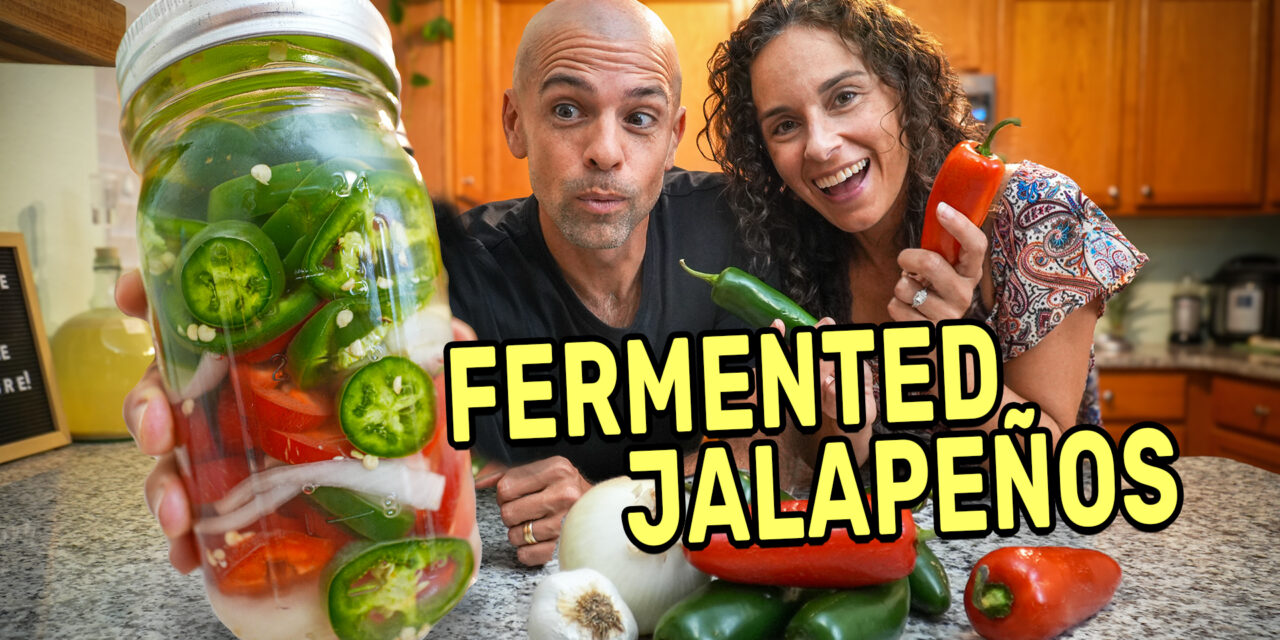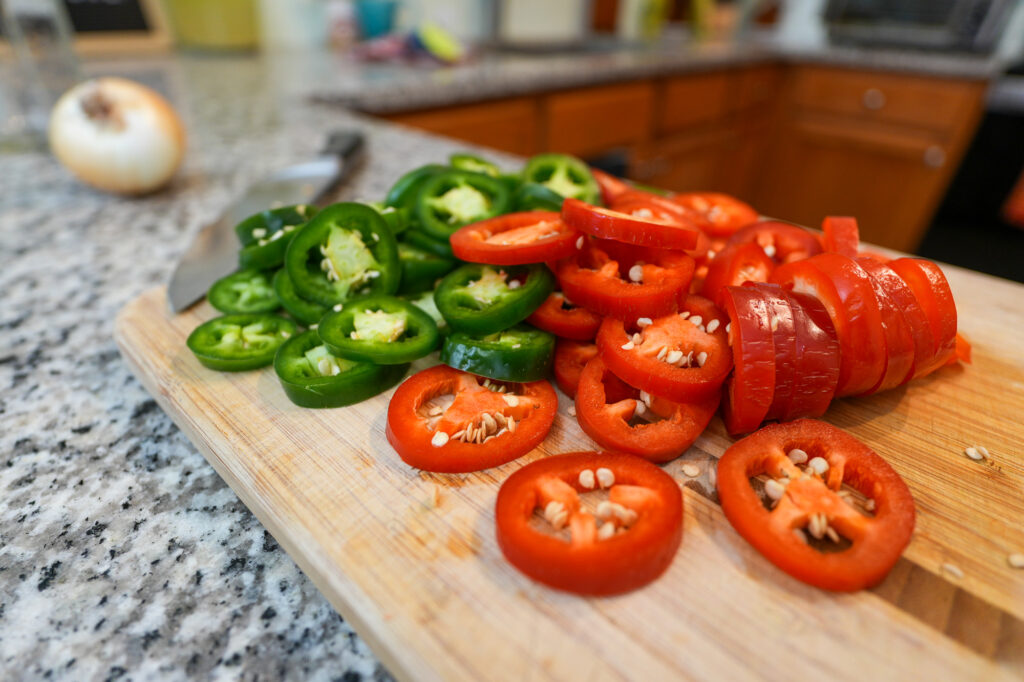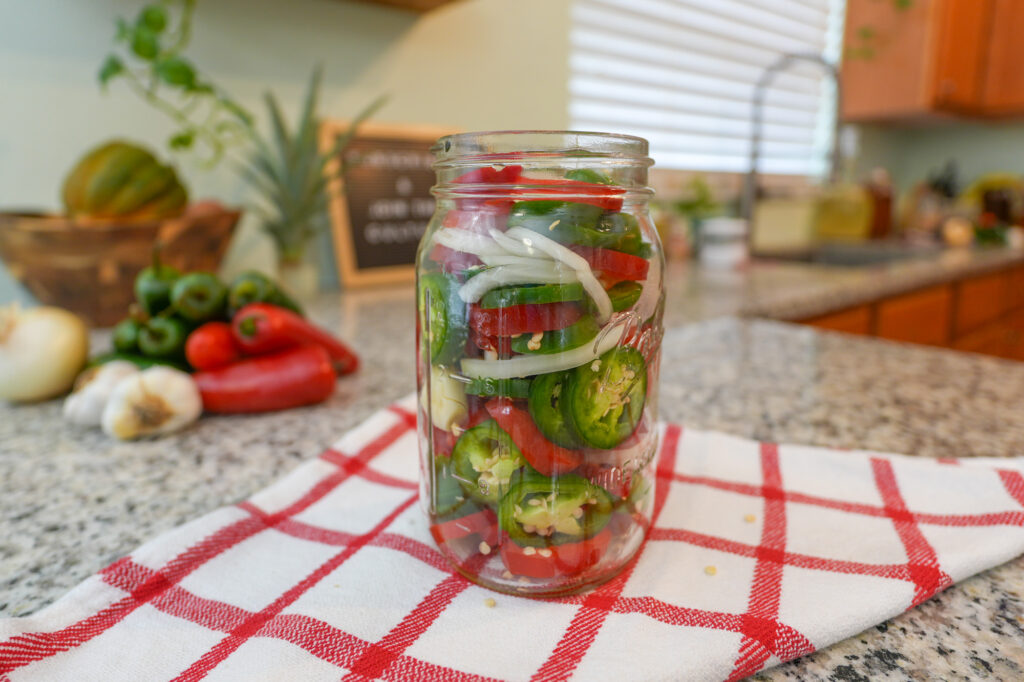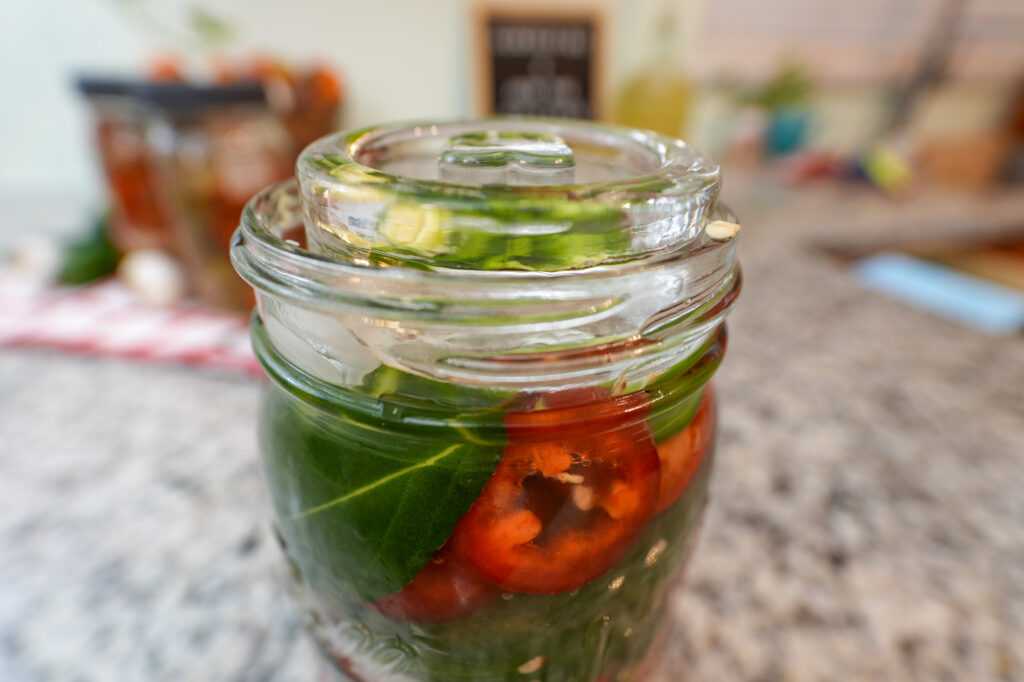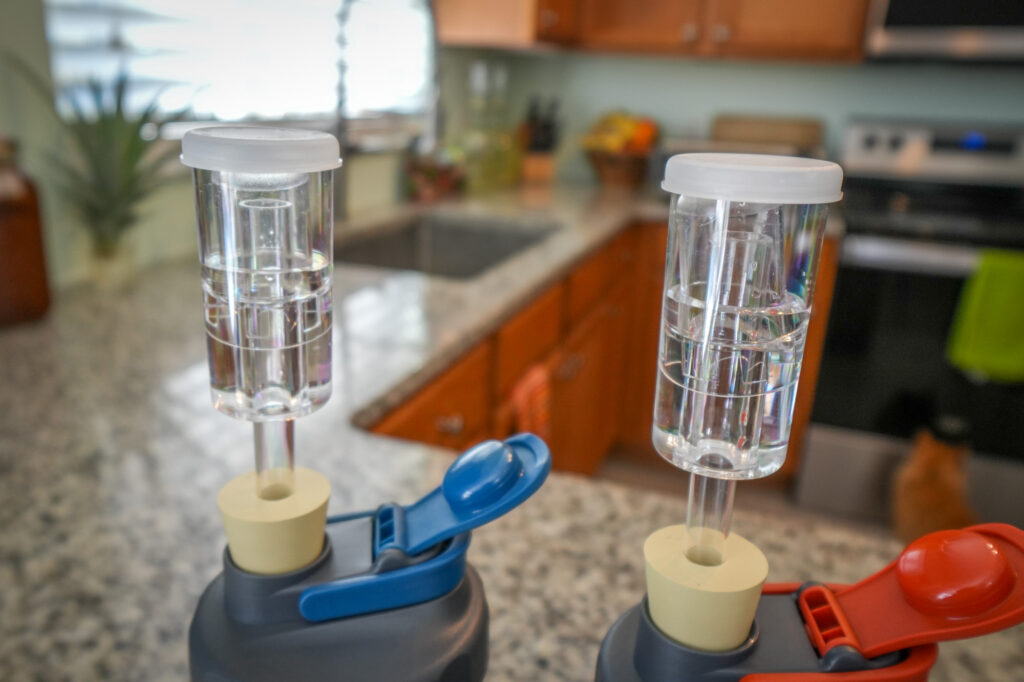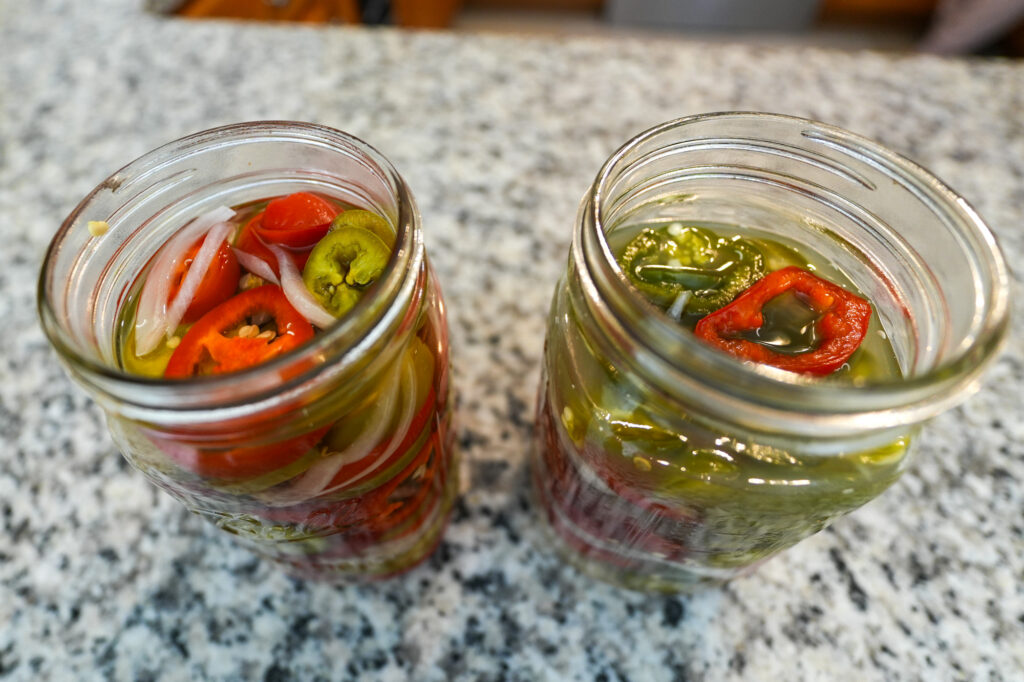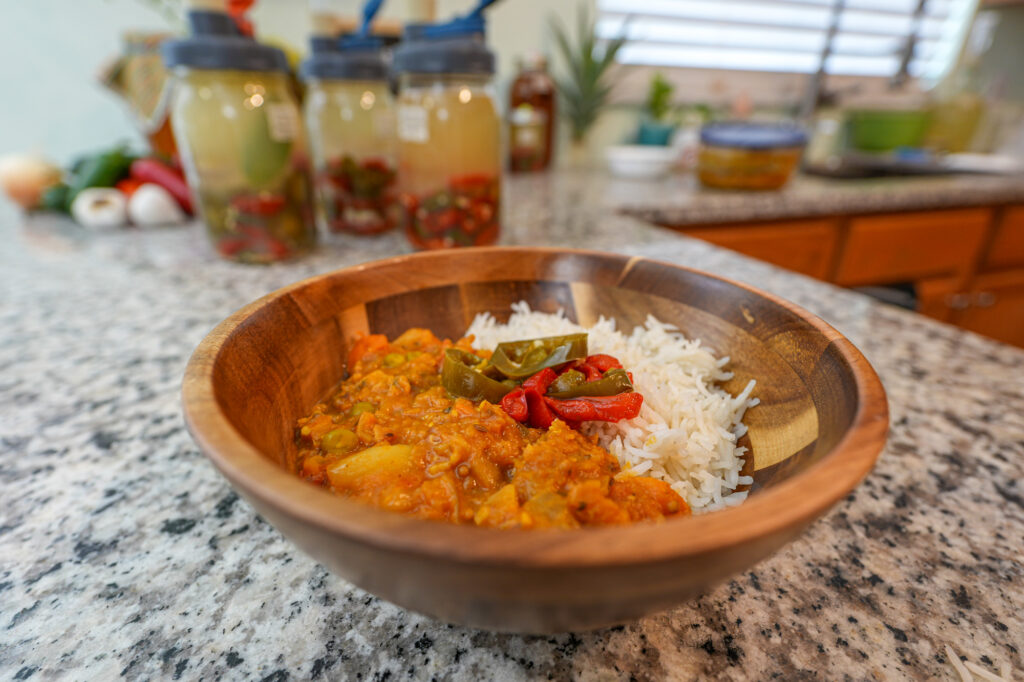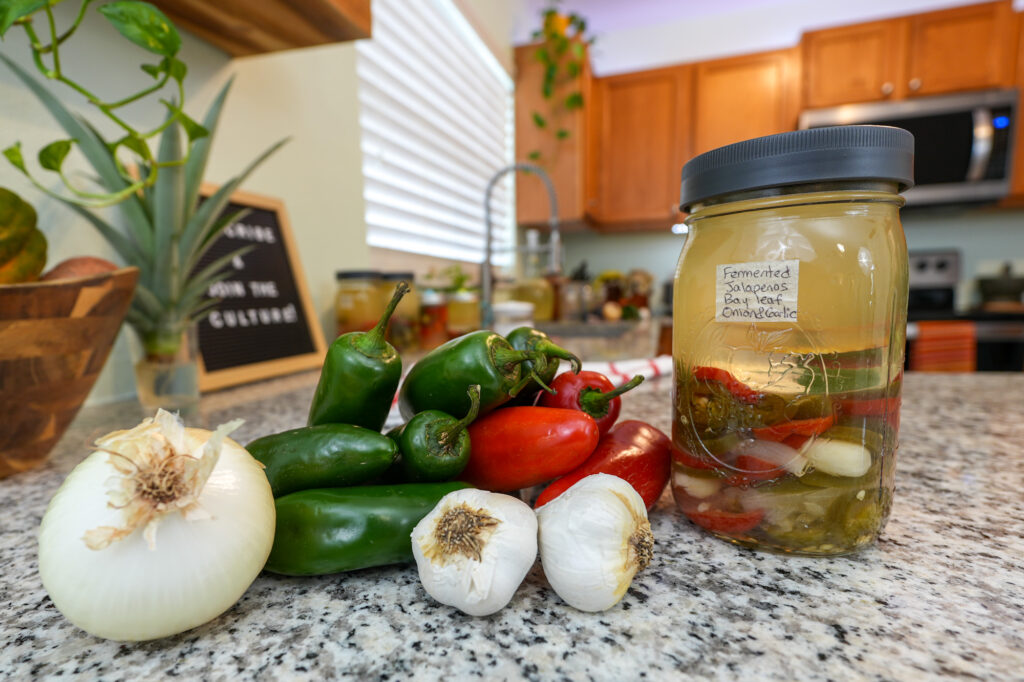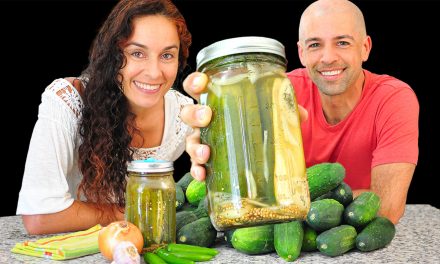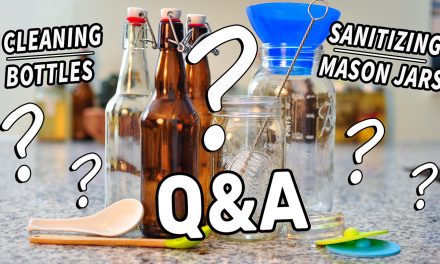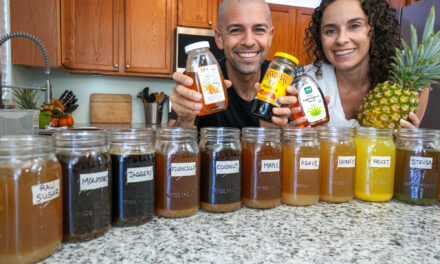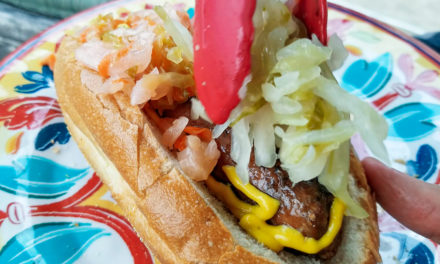If you love tangy, delicious hot peppers you’re going to love our recipe below for lacto-fermented jalapenos! They’re different than any jar of peppers you can buy at the store and full of healthy probiotics! And if you also love the taste of traditional pickled jalapeno peppers made with vinegar, we’ve included that recipe too so that you can make them both.
Check out the full video and subscribe to our YouTube channel. We appreciate your support! ❤️
Lacto-Fermented Jalapeno Peppers Recipe
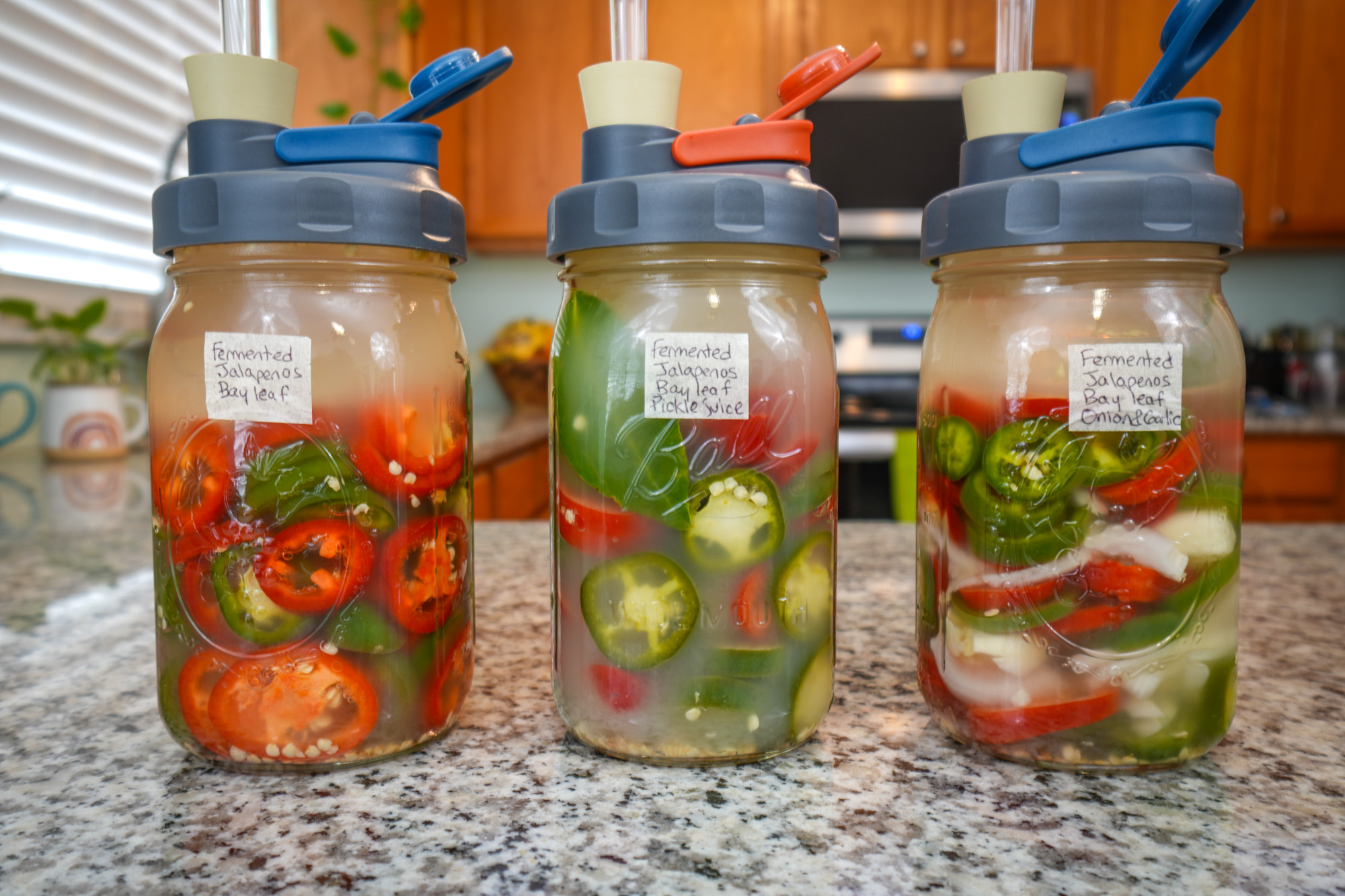
Three ways to make fermented jalapenos: 1) Peppers only 2) Adding a starter culture (like pickle juice) 3) Adding onions & garlic for good flavor
Equipment
- 1 quart Mason Jar
- Fermentation weight <– We love these!
- Flip-top Lids <– multi-purpose & new favs!
- 3 Piece Airlocks <– fit with flip-top lids above
- Rubber Stoppers <– fit with flip-top lids above
- Fermentation lids <– silicone lids that work well for us
- Food pH Meter <– to test acid level
Ingredients
- 6 Jalapeno peppers, green or red
- 1/4 Onion, sliced thin
- 2 Garlic cloves, smashed
- 2 tsp Sea salt (ratio of 1 tsp / cup water)
- 1 Bay leaf
- Water, non-chlorinated
Directions
- Wash and rinse your mason jars and jalapenos.
- Slice jalapenos into rounds and fill your mason jar 3/4 full.
- Slice your onions, smash your garlic, and add to jar, up to the neck of jar.
- Add the bay leaf anywhere in the jar.
- Fill glass measuring cup with 2 cups non-chlorinated water and mix in 2 tsp salt.
- Pour brine into mason jar to cover contents just below the neck of jar.
- Place fermentation weight in mouth of mason jar to weigh down all ingredients below the surface of the brine.
- Leave at room temperature on the counter and ferment to taste. For us, our fermenting environment is 74 degrees Fahrenheit, so three days is perfect for fermented peppers.
- You can also test the pH level by using a food pH meter to make sure the pH falls below 4.6. Enjoy!
Notes & Suggestions
- You can make fermented peppers without adding any other flavors (but we love the flavors of onion and garlic).
- To kick-start your ferment by about a day, you can add some kind of starter like pickle juice, sauerkraut juice, or any other type of lacto-fermentation starter.
- Feel free to taste it along the way! It might taste better to you the longer it goes. It also might take longer or shorter depending on the temperature of your fermenting environment.
Lacto-Fermented Peppers – What to Expect During Fermentation
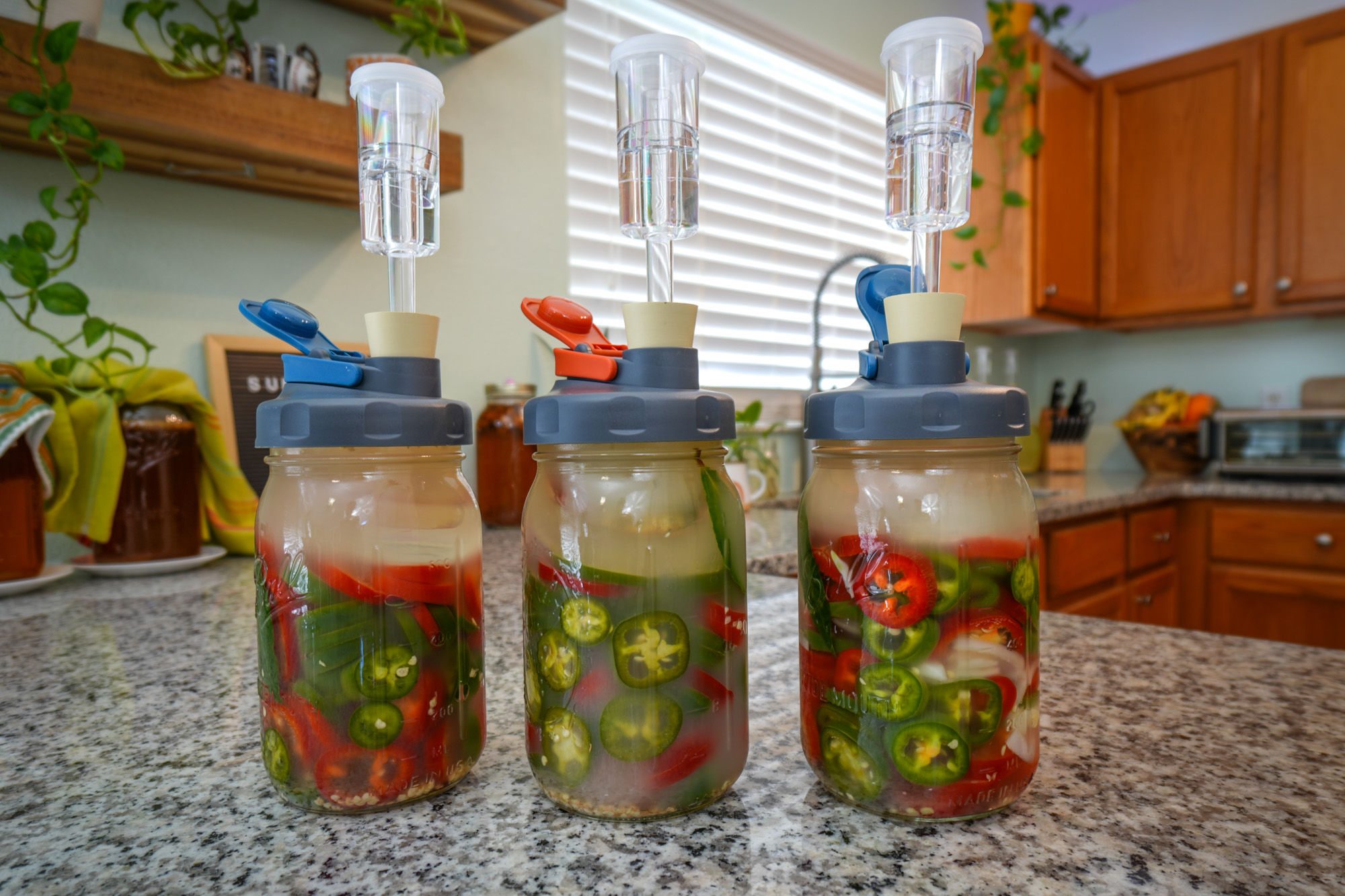
For the first 24 hours, it will look beautiful, vibrant and clear. You shouldn’t see any bubbles unless you had added some kind of lactic acid starter culture to your jar. Amazingly, our jar with additional pickle juice started bubbling within the first day! Without using a starter culture though, you will probably start seeing bubbles after two full days.
Once you start seeing many pockets of air (which create bubbles when the jar is moved), the brine in the jar should also be slightly cloudy. This is a good sign that fermentation is happening! We like to slightly jiggle the jar to see if any bubbles come free that have formed in between the peppers. The nice thing about this air lock is that it doesn’t allow oxygen or anything else get into the jars, which could cause mold, while still allowing the excess carbon dioxide to escape. It’s a fun process to watch the bubbles escape out of the air lock.
By the third day our jar is happily bubbling away on the counter, in an environment around 74 degrees F. This is around the time when we like the flavor the best. Once it’s to your liking, you can remove the air lock, put on a loose lid (or leave on a silicone fermentation lid), and move them into the refrigerator to slow down the fermentation process. They will continue to ferment very slowly in the fridge and develop even more delicious flavor.
🌶️ Now, have you tried pickling jalapenos? It’s fun to compare these two methods of food preservation!
Pickled Jalapeno Peppers Recipe (with vinegar)
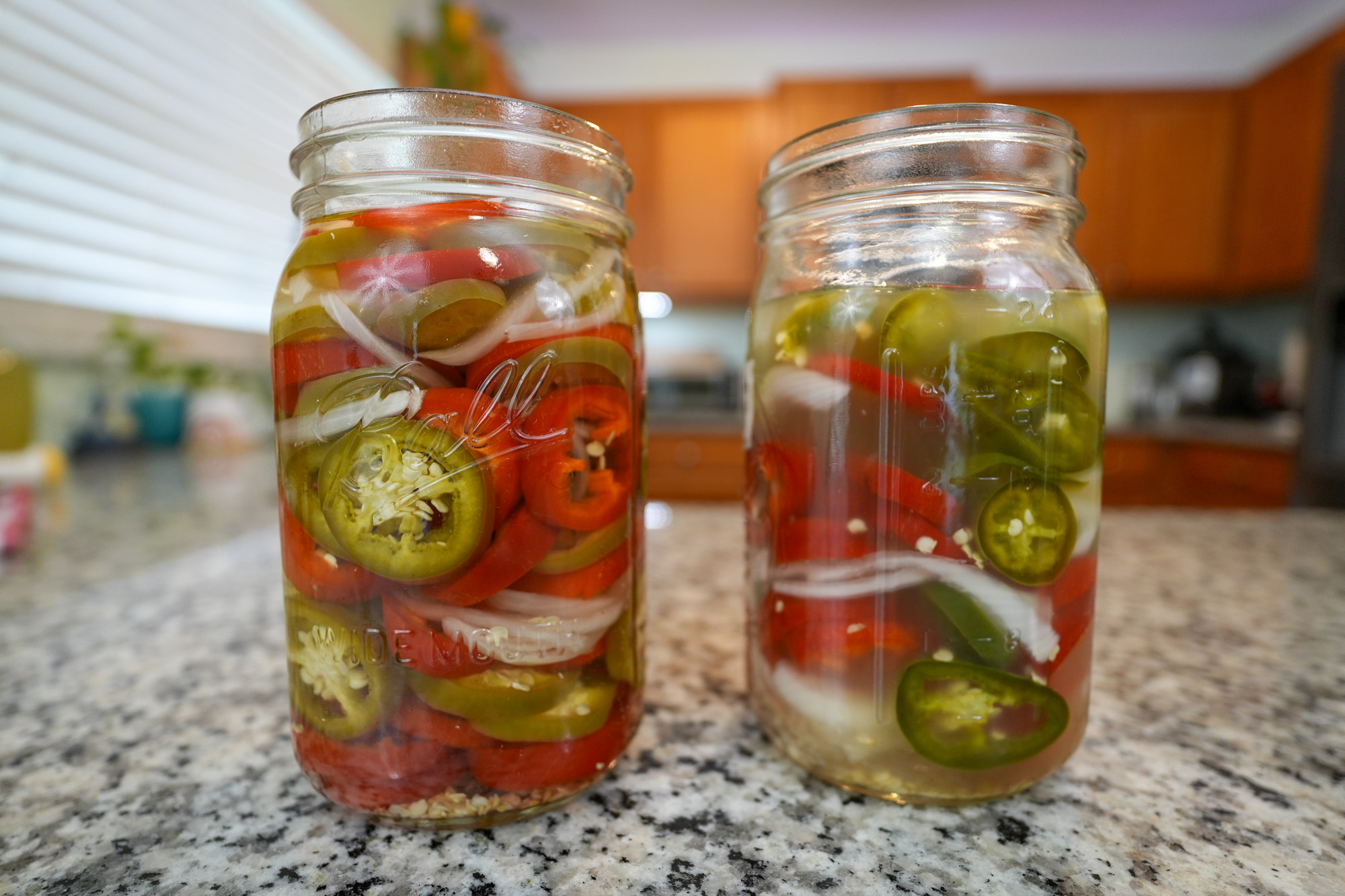
Pickled Jalapenos (left), Fermented Jalapenos (right)
Equipment
- 1 quart Mason Jar
- Wide-mouth leak-proof mason jar lids – we love these lids!
Ingredients
- Jalapeno peppers, green or red (enough to fill the jar 3/4)
- 1/4 Onion, sliced thin
- 2 Garlic cloves, smashed
- 2 tsp Sea salt (ratio of 1 tsp / cup water)
- 1 cup water
- 1 cup distilled white vinegar
Directions
- Wash and rinse your mason jars and jalapenos.
- Slice jalapenos into rounds and fill your mason jar 3/4 full.
- Slice your onions, smash your garlic, and add to jar, up to the neck of jar.
- Bring to boil equal parts water and distilled white vinegar, as well as the salt.
- Pour brine into mason jar to cover contents just below the neck of jar.
- Cool and place in the refrigerator for at least two hours before serving.
What about hot sauce?
Yes! You can easily use either of these recipes to make yourself a nice tasty bottle of hot sauce! Here’s our original video on how to make homemade fermented hot sauce.
Fermented vs. Pickled
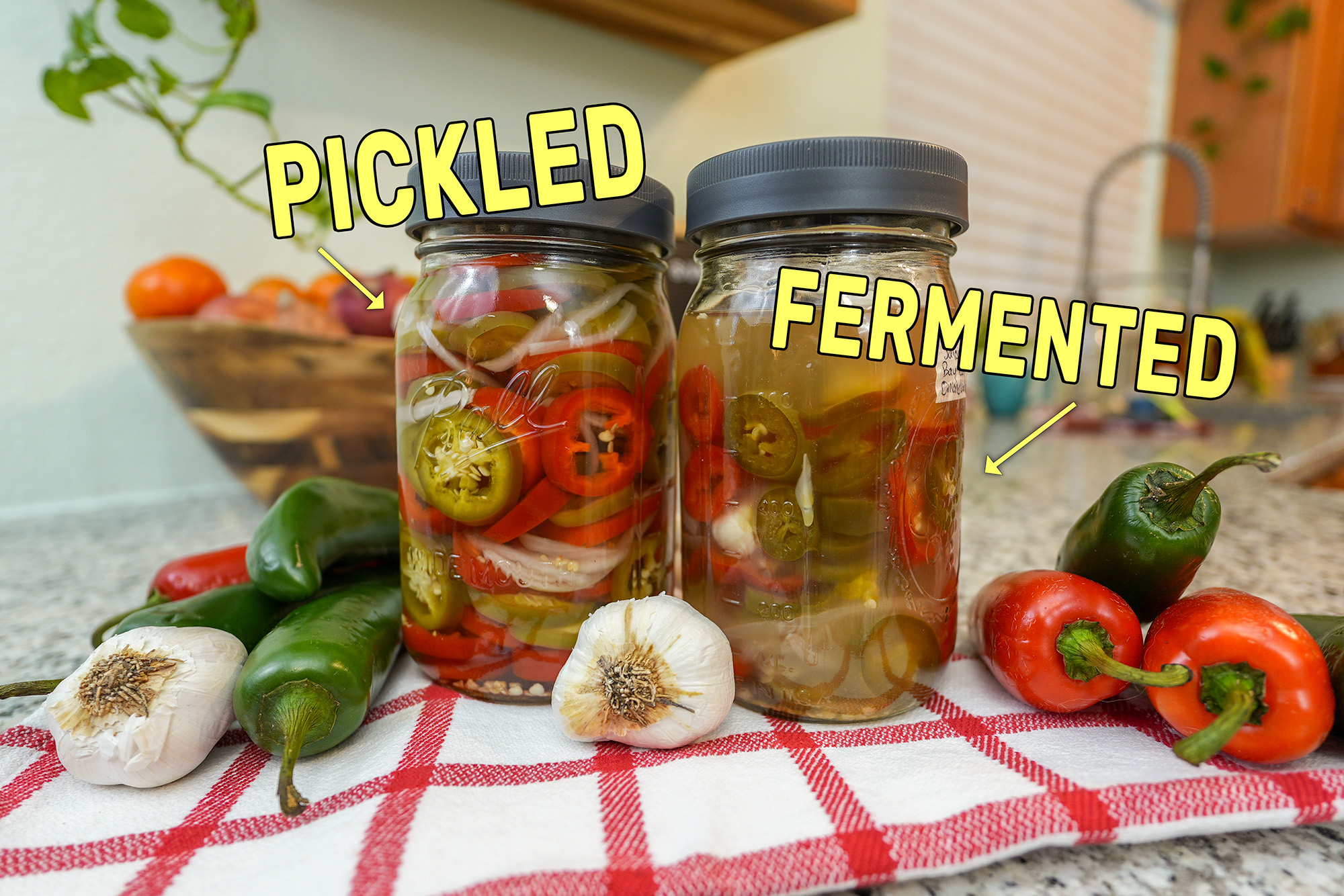
It might seem easy to mistake fermented peppers for pickled peppers. Both taste of vinegar, but what’s the difference?
Fermented Peppers & Fermentation
When you make fermented peppers, through wild fermentation, lactic acid bacteria and yeast eat the sugars, release carbon dioxide, and create the delicious rich and tangy flavors of lactic acid. Bacteria and yeast multiply and create our wonderful living probiotics. The peppers become a little softer the longer they ferment, which can be good for making hot sauce as well. Since the end result is acidic and lower than 4.6 pH, it prevents botulism from growing.
Pickled Peppers & Pickling
When you pickle peppers, you’re boiling distilled vinegar that then gets poured over your peppers and kills all of the living bacteria and yeast. Since you’re cooling the mixture down quickly it keeps the peppers crunchy and the flavors are slightly sweeter from the distilled vinegar. Since it uses vinegar that’s already an acid lower than 4.6 pH, it also prevents botulism from growing.
Which is better – fermented or pickled?
That’s up to you! They’re both great, taste very different, and have different qualities. Lacto-fermented peppers are softer, but full of probiotics with an enhanced flavor. Pickled peppers are crunchier, sweeter, and quicker to make. Try making each and see which one you like best!
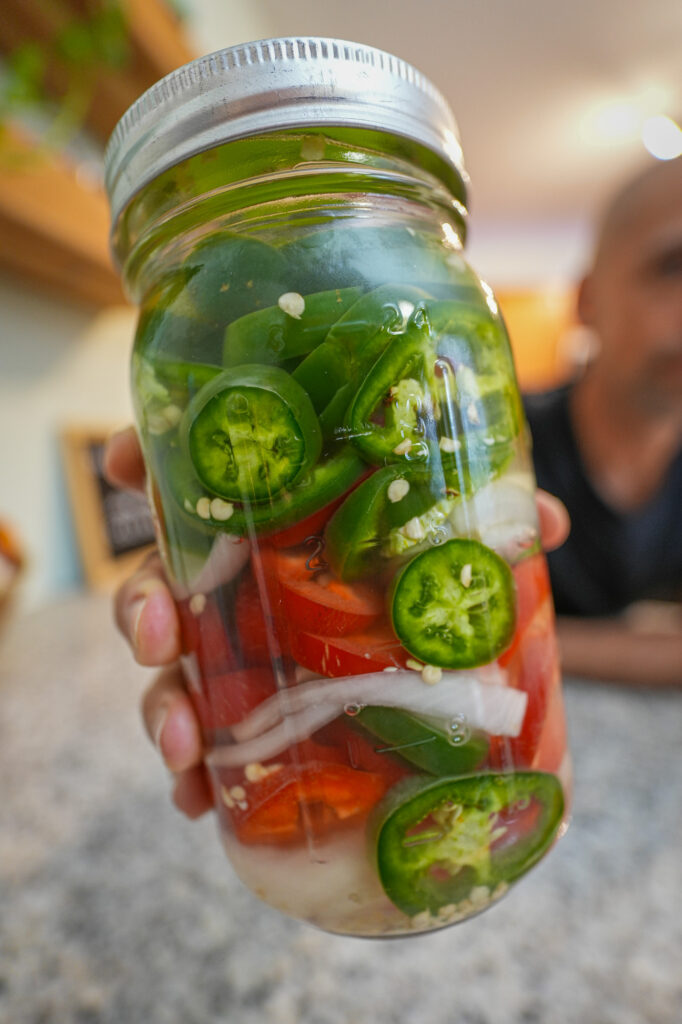
We hope you enjoy these recipes!
If you haven’t already, we’d love for you to subscribe to our YouTube channel so you don’t miss any new videos!

